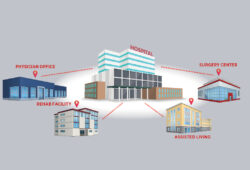Best practices for involving surgeons in the supply chain decision-making process
From knee replacements to angioplasties, the work of surgeons requires a high level of skill, expertise and poise under pressure. And although their contributions to healthcare can be a matter of life or death in the OR, surgeons can also be integral to other facets of medicine—including the supply chain.

Because surgeons are the end-users of countless products procured by the supply chain, their involvement in the decision-making process only makes sense, says John Young, M.D., MBA, Chief Medical Officer at HealthTrust.
“Beyond reimbursement, surgeons are best positioned to weigh in on the balance between cost, quality and outcomes—and ultimately the potential for standardization,” Dr. Young says.
When healthcare systems can engage surgeons in choosing and committing to certain suppliers and products, the supply chain process is more clinically integrated, leading to quality control, efficiency and cost savings—benefitting surgeons, health systems and, most important, patients.
For facilities looking for tips on bringing surgeons into this conversation, here are the rules of engagement.
Demonstrate the system-wide benefits

Engaging surgeons in supply chain decisions has myriad benefits, from cutting unnecessary costs to improving patient outcomes through new technology, says Matthew P. Willis, M.D., an orthopedic surgeon with Tennessee Orthopaedic Alliance.
Dr. Willis says a benefit of surgeon engagement is that when clinicians are involved in the decision-making process for products, they feel as though they’re providing their patients with the best care possible. It also helps ensure that hospitals are properly using emerging technology instead of remaining stagnant and relying on less-advanced devices.
Surgeons understand the goal of hospitals and administrators when it comes to cost containment, Dr. Willis says. When surgeons are integrated into the process, they are able to voice their opinion on the quality aspect of all products.
“When we’re engaged, we feel like we’re part of the system,” he says. “It boosts overall satisfaction when we feel like we’re involved—that leads to happier and more productive physicians.”
In addition, surgeons can see that cost savings from product changes can allow for more optimized spending in other areas within the hospital—such as more modern operating rooms—which supports patients, surgeons and administrators alike.
“Reduction in variability and elimination of waste that is often not readily recognized can lead to significant savings that can be invested elsewhere within the system—or service line—to improve performance,” Dr. Young says.
Identify potential roadblocks
Although there are notable advantages to engaging surgeons in the supply chain, it’s not always a simple process. It’s no secret that most people are opposed to change. Surgeons are no different. “If a surgeon is comfortable with a certain implant and they’ve used the same one for years, it might make them nervous to think about switching,” Dr. Willis explains. He notes that although the learning curve is typically small when it comes to using a new implant, anchor, joint replacement, plate or screw, it’s still there, and it might affect surgeons’ openness to trying new products.
Encourage buy-in
Surgeons often take several factors into consideration when deciding whether to switch products. Ensuring the following priorities are in place can help surgeons get on board with clinically integrating supply chain decisions:
Choice. Dr. Willis says the No. 1 driver of surgeon buy-in when it comes to new implants and devices is the idea of having options. “If doctors feel like they have a choice between implants A, B and C, that gives them more satisfaction,” he says.
Transparency. As a surgeon, Dr. Willis values administrators being open about goals when they approach surgeons about supply chain decisions. “Physicians want to see transparency with the cost-containment process,” he says, “sitting down and saying, ‘Here’s what we’d like to save, can you help us out?’ ”
Dr. Young agrees that transparency is of the utmost importance. Because some surgeons are resistant to changing their preferred tools and supplies for specific procedures, communicating openly and honestly about the goals and potential benefits of making certain changes can make a world of difference, he explains.
“Sharing data around unwanted variability and waste can open the dialogue and demonstrate the improved efficiencies and outcomes associated with standardization and evidence-driven care,” Dr. Young adds.
Quality. “There’s one constant that virtually none of us would sacrifice: quality,” Dr. Willis says. During the supply chain decision-making process, it’s crucial to provide data supporting a product’s efficacy.
Dr. Young says that when quality is at the forefront of the conversation, the discussion about cost will inevitably follow.
“The most important point is to come at this from a quality perspective—driving efficiencies in care delivery and elimination of waste,” Dr. Young says. “A data-driven approach to those two elements will naturally lead to a conversation around cost as an important component of the overall value equation.”
It’s particularly important to involve surgeons at the beginning of the decision-making process.
“Engaging surgeons in the value analysis discussion early on is critical,” Dr. Young says, adding that establishing a committee that reviews new products and technology could be a natural way to start this conversation. “The structure of that committee can lead to the identification of opportunities to improve quality while simultaneously driving out costs.”

HealthTrust’s inSight Advisory Solutions can help healthcare systems engage surgeons to reduce waste. Drew Preslar, AVP inSight Advisory Solutions, suggests the following:To build consensus with surgeons and improve supply efficiency in the OR, base the conversation on data. Gather metrics, such as how many items are opened in the OR but not used, or how often products are used but not identified on the surgeon’s preference cards.
- Meet with surgeons one-on-one to review preference cards. Discuss whether any products can be eliminated, as well as whether it’s necessary to open every product prior to a procedure. In some cases, it’s possible to use a secondary “hold table” in the OR for unopened products that may or may not be used for a patient.
- During the onboarding process, facilitate conversations between supply chain leaders and newly employed physicians. Surgeons who are accustomed to using particular products at their former employer may request off-contract products.
- Consider appointing a “physician operations executive” or POE. POEs have financial responsibility for the operation of their hospitals and can encourage physicians to eliminate wasteful practices.
To discuss how inSight Advisory can assist you in reducing OR waste, contact AVP Drew Preslar.






